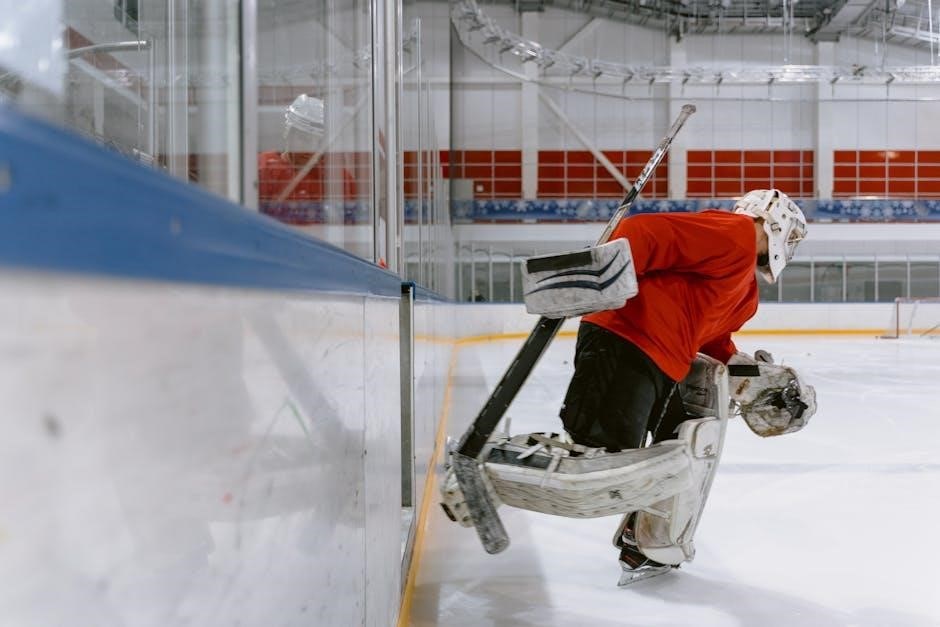Finding the perfect Bauer skate fit is crucial for performance and comfort․ This guide helps you navigate Bauer’s sizing system, ensuring optimal agility, control, and enjoyment on the ice․ Learn how to achieve the ideal fit․
Welcome to the comprehensive guide to Bauer skate fitting! Achieving the right skate fit is paramount for maximizing performance, comfort, and preventing injuries on the ice․ Bauer, a leading manufacturer, offers a range of skates designed to cater to various foot shapes and playing styles․ This introduction will walk you through the essentials of Bauer skate fitting, covering everything from understanding foot anatomy to utilizing Bauer’s innovative 3D fit system․ Whether you’re a seasoned player or just starting out, this guide will equip you with the knowledge to find the perfect Bauer skates for your needs․

Understanding Foot Anatomy for Skate Fit
Proper skate fit begins with understanding your foot․ Foot shape, volume, and arch type significantly impact skate selection․ Knowing these aspects ensures comfort and performance, preventing discomfort and enhancing your skating experience․
Importance of Foot Shape and Volume
Foot shape and volume play a pivotal role in achieving the correct skate fit․ Skates are designed with varying internal dimensions, and understanding your foot’s unique characteristics is key․ A skate that doesn’t match your foot shape can lead to discomfort, blisters, and compromised performance․ Considering the volume, or overall size, of your foot ensures the skate provides adequate support without being too tight or loose․ Factors like arch height and width should also be assessed to select a skate that complements your foot’s natural contours, maximizing comfort and efficiency on the ice․

Measuring Your Feet for Bauer Skates
Accurate foot measurement is vital for selecting the correct Bauer skate size․ This section guides you through using a Brannock device and measuring at home to ensure a precise fit․
Using a Brannock Device or Measuring at Home
To begin, either visit a store with a Brannock device for a professional measurement, or measure at home․ When measuring at home, stand with your heel against a wall and measure the length of your foot․ Note the measurement in inches or centimeters․ To get the most accurate measurement, make sure to wear socks that you would wear while skating․ This measurement will then be converted into Bauer skate sizes using a sizing chart․
Converting Shoe Size to Bauer Skate Size
Generally, Bauer skates fit 1 to 1․5 sizes smaller than your regular shoe size․ For example, if you wear a size 8 US men’s shoe, you might start with a size 6․5 or 7 Bauer skate․ However, this is just a starting point․ Use a Bauer size chart and the foot measurement you recorded from using the Brannock device․ Different lines of skates within Bauer may also fit differently, so refer to the specific skate model’s sizing recommendations for the best results․
Bauer’s 3D Fit System Explained
Bauer’s 3D Fit System revolutionizes skate fitting․ Utilizing data from foot scans, it offers three distinct fit profiles․ This ensures players achieve a comfortable and performance-enhancing fit, moving beyond traditional width sizing․
Fit 1, Fit 2, and Fit 3: What They Mean
Bauer’s 3D Fit system replaces traditional D and EE widths with Fit 1, Fit 2, and Fit 3․ Fit 1 caters to players with narrow feet, providing a snug, performance-oriented feel․ Fit 2 is designed for average foot shapes, offering a balance of comfort and responsiveness․ Fit 3 accommodates wider feet, ensuring ample volume and a comfortable fit․ Understanding your foot’s profile is essential for selecting the correct fit number․ This innovative system ensures a more customized and precise skate fit for all players, enhancing performance;
How the 3D Foot Scan Works
The Bauer 3D foot scan offers a precise method for determining your ideal skate fit․ Utilizing advanced technology, the scanner captures detailed measurements of your foot’s length, width, volume, and unique contours․ This data is then analyzed to recommend the appropriate Bauer skate size and fit profile (Fit 1, Fit 2, or Fit 3)․ The scan eliminates guesswork, providing accurate information for a customized fit․ Many retailers offer this service, ensuring you select skates that optimize comfort, performance, and reduce the risk of discomfort or injury․ It provides precise, accurate information;
Understanding Skate Width Options
Skate width is crucial for comfort and performance․ Options like D and EE accommodate various foot shapes․ Understanding these variations ensures a proper fit, preventing discomfort and optimizing your skating ability on the ice․
D, EE, and Other Width Variations
D and EE are common skate width options, with EE offering a wider fit than D․ Manufacturers use these widths across skate families, which can vary within a brand․ Bauer, for example, uses these sizes․ Choosing the right width is essential for comfort, performance, and preventing issues like heel lift․ If your heel moves in the skate, it’s a sign of an improper fit․ Consider a 3D foot scan for precise fitting․ Remember, a well-fitted skate is key for agility and control․

Checking the Fit Out of the Box
A new skate should feel like a “firm handshake․” Toes should brush the cap when standing․ When bending knees, toes should lightly touch the front․ This ensures proper fit before heat molding․
The “Firm Handshake” Feel
The initial feel of a correctly fitted skate should resemble a “firm handshake,” providing a snug and secure sensation around your foot․ When you first stand with the skates laced, your toes should be just brushing the front of the toe cap․ This indicates a proper length․ It shouldn’t feel cramped or overly loose; The skate should hold your heel firmly in place․ This prevents unwanted movement․ A good fit allows for optimal energy transfer․ It also enhances control on the ice․ This initial feel is a vital sign for overall comfort and performance․
Toe Placement and Knee Bend Test
After achieving the “firm handshake” feel, the toe placement and knee bend test is crucial․ Stand in your laced skates and ensure your toes lightly brush the front of the skate․ Next, bend your knees as if you are in a skating stance․ As you bend, your toes should pull back slightly from the front of the boot․ This indicates adequate room and proper forward flex․ If your toes are jammed against the front, the skate might be too small․ Conversely, if your toes are far from the front, it could be too large․
Heat Molding for a Custom Fit
Heat molding offers a personalized fit by conforming the skate’s stiff materials to your foot’s unique shape․ Baking your skates enhances comfort and performance, creating a truly customized feel for optimal skating․
The Benefits of Baking Skates
Baking your skates in a specialized oven allows the stiff boot materials to become more pliable and moldable, resulting in a customized fit․ This process significantly enhances comfort by eliminating pressure points and conforming the skate precisely to the contours of your foot․ Heat molding improves performance by maximizing energy transfer, providing better support, and increasing responsiveness․ A custom fit also reduces the risk of blisters and discomfort, allowing you to focus entirely on your game and improve your skating performance․ Ultimately, baking skates optimizes the fit, feel, and performance for an enhanced experience․
Step-by-Step Heat Molding Process
First, preheat your oven to the manufacturer’s recommended temperature, typically around 175-200°F (80-93°C)․ Remove the insoles from your skates and loosen the laces completely․ Place the skates in the oven for the specified time, usually 8-10 minutes․ Carefully remove the skates and immediately put them on, lacing them snugly but not too tightly․ Sit with your knees bent at a 90-degree angle for 10-15 minutes, allowing the skates to cool and mold to your feet․ After cooling, remove the skates and replace the insoles․ Let the skates sit for 24 hours before using them to allow the shell to fully harden․
Identifying Signs of a Poorly Fitted Skate
Recognizing a poor skate fit is essential․ Key indicators include heel lift, excessive ankle movement, and experiencing pain or discomfort․ Addressing these issues ensures optimal performance and prevents potential injuries on the ice․
Heel Lift and Ankle Movement
Heel lift, where your heel moves excessively within the skate, signifies a poor fit․ Excessive ankle movement similarly indicates inadequate support․ Both issues compromise stability and control, hindering performance and potentially causing discomfort or injury․ If your heel moves noticeably while skating, or if your ankle feels unsupported, the skate’s fit should be re-evaluated․ A properly fitted skate should securely hold your heel and ankle, providing necessary support for efficient skating․ Seek expert assistance if needed to address these fitting problems․
Pain Points and Discomfort
Persistent pain or discomfort within your skates is a clear indication of fit issues․ Common pain points include the sides of the feet, toes, or ankles․ These issues may result from skates that are too narrow, too tight, or improperly shaped for your foot․ Ignoring these signals can lead to blisters, calluses, or more severe foot problems․ Evaluate your skates and consider adjustments or a different size if you experience persistent pain․ Don’t compromise your comfort or foot health․ Addressing pain points ensures enjoyable skating experiences;

Bauer Skate Size Chart
Consulting a Bauer skate size chart is essential for finding the right fit․ These charts provide conversions between shoe sizes and Bauer skate sizes, ensuring optimal performance and comfort on the ice․
Adult (Senior) Sizes
For adult players, Bauer senior skate sizes typically correspond to men’s US shoe sizes․ Generally, select a skate size 1 to 1․5 sizes smaller than your shoe size․ For example, if you wear a men’s US size 9 shoe, a Bauer senior skate size of 7․5 or 8 might be appropriate․ Always refer to the specific Bauer size chart for the most accurate conversion, as sizing can vary slightly between models․ Remember that the fit should be snug, with your toes lightly brushing the front of the skate when standing․
Junior and Youth Sizes
When fitting junior and youth players, Bauer skate sizes correlate with smaller shoe sizes․ Junior skates generally fit children aged approximately 7 to 13 years old․ Youth skates are designed for even younger skaters․ As a general rule, go down 1․5 sizes from the child’s shoe size․ So, if a child wears a size 3 shoe, a size 1․5 Bauer skate might be a starting point․ Always consult the Bauer size chart and consider a professional fitting to ensure the most accurate and comfortable fit for growing feet․ Proper fit is essential for development․
Converting Old Bauer Sizes to the New Fit System
Bauer’s transition to the 3D Fit system (Fit 1, Fit 2, and Fit 3) has changed how skaters determine their ideal skate size․ If you’re accustomed to older Bauer skate sizing (D or EE widths), converting to the new system requires careful consideration․ It is important to reference a conversion chart provided by Bauer to find the corresponding Fit profile and size․ Remember that the Fit system focuses on foot volume and shape, not just width․ Consulting with a skate fitting expert can further assist in accurately converting your old size and ensuring optimal comfort and performance in the new system․
Skate Runner Sizing Guide
Selecting the correct runner size is essential for optimal performance․ Use the three-digit code on your skate holder to determine the corresponding runner size․ This ensures proper balance and blade contact with the ice for enhanced skating․
Finding the Correct Runner Size
Locating the right skate runner size is crucial for optimal performance and safety on the ice․ All Bauer skates have a three-digit number located on the back corner of the holder․ This number corresponds to your ideal runner size․ If your skate lacks this number, consult a conversion chart to match your skate size to the appropriate runner size․ Ensuring the correct runner size guarantees proper balance, stability, and efficient energy transfer, ultimately enhancing your skating experience and minimizing the risk of injury․ A properly sized runner will optimize your stride and maneuverability․
Fine-Tuning Fit with Aftermarket Products
Aftermarket products like Speed Plates can enhance comfort and performance․ Speed Plates, when heated, become pliable for custom placement inside the skate, improving fit and responsiveness․ This fine-tuning optimizes the skating experience․
Using Speed Plates for Enhanced Comfort
Speed Plates offer a method for customizing skate fit and enhancing comfort․ After heating the Speed Plate, allow it to cool slightly before carefully inserting it into the skate, ensuring the skate is in a wide-open position with loose lacing and the tongue out․ This pliability allows for optimal placement within the skate’s bottom․ Wait briefly before fully inserting the Speed Plate․ This customization enhances comfort and improves energy transfer, leading to better performance on the ice by creating a personalized fit․






